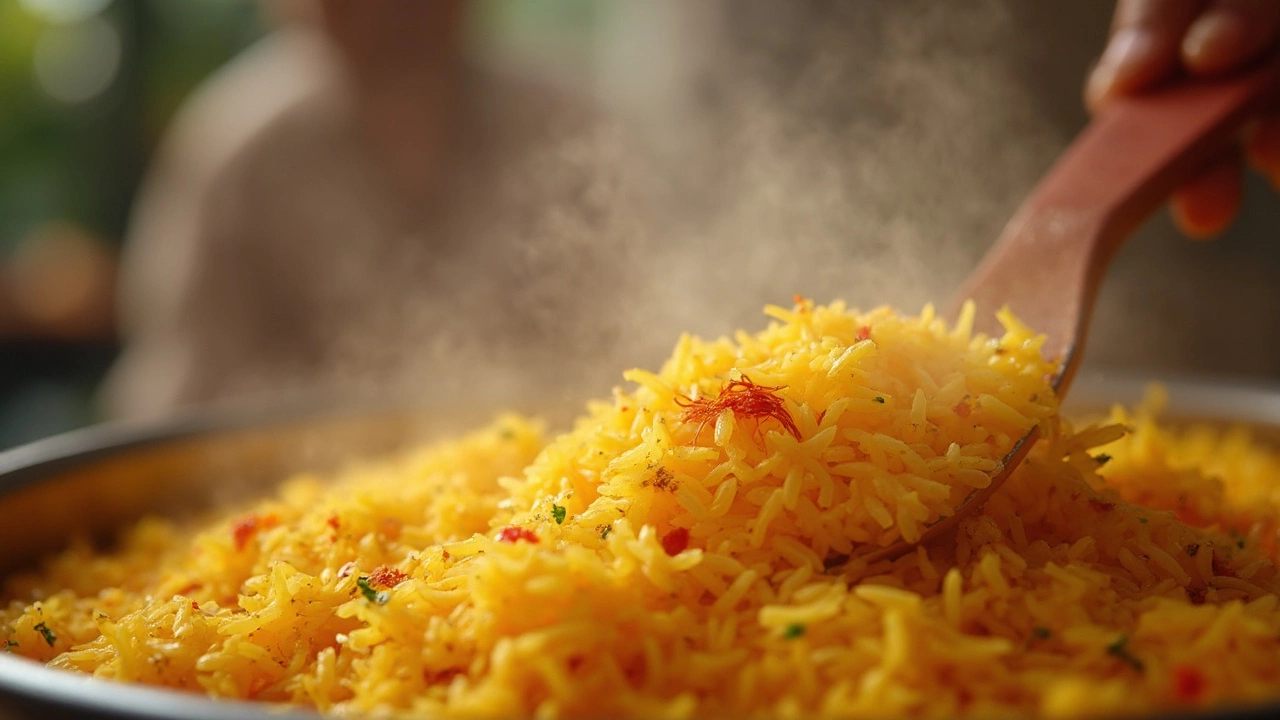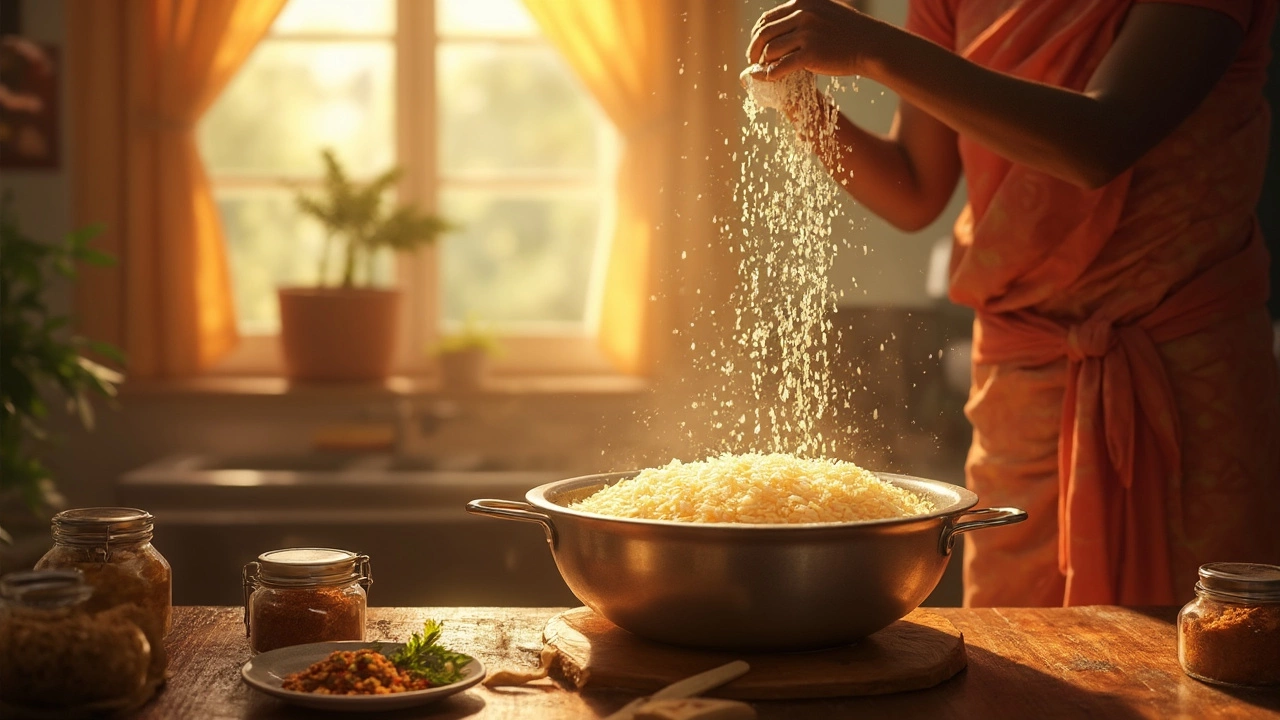19 Jun 2025
- 0 Comments
If you’ve ever ended up with mushy or sticky biryani, nine times out of ten, it’s the rice prep causing trouble. Soaking basmati rice isn’t just some old-school thing your grandma did; it actually changes how your biryani turns out. Skipping this step? You risk clumpy grains and uneven cooking—seriously, it’s a rookie move.
To nail that light and fluffy biryani, you need to soak your basmati rice just right. Not too short, not all day—there’s a sweet spot, and it makes a world of difference on your dinner plate. Proper soaking lets the grains puff up, so they cook evenly and don’t stick together. You’ll taste that difference in every bite.
- Why Soak Basmati Rice for Biryani?
- Ideal Soaking Time: What Actually Works
- What Happens If You Skip or Overdo It?
- Pro Tips for Perfect Biryani Rice
Why Soak Basmati Rice for Biryani?
If you want each grain of rice in your biryani to stand out, soaking is not optional. The point of soaking is pretty simple: it helps the rice absorb some water before you start cooking. This gets the grains ready to expand without bursting open or turning mushy in the pot.
When you soak basmati rice, the grains start to absorb water from the outside in. That’s why they grow longer—sometimes up to twice their size. Dry rice cooks unevenly because the outside cooks way faster than the inside. Soaking balances that out, so you don’t get a weird mix of crunchy and soggy in one bite.
- Soaked rice cooks faster and more evenly.
- The grains are less likely to split and become sticky.
- You get those long, fluffy grains that just look and taste better in biryani.
Here’s a quick table showing what’s really going on when you prepare your rice:
| Soaking Time | Average Grain Length After Cooking | Texture Result |
|---|---|---|
| Not soaked | 7-8 mm | Sticky, uneven |
| 30 minutes | 11-13 mm | Fluffy, separates easily |
| Over 1 hour | 13+ mm (may split) | Soft, risks breakage |
One more reason to soak: it actually makes your rice less starchy. The extra starch comes off and can be rinsed out easily, giving you a lighter biryani. If you skip soaking, you’ll probably wonder why your soak basmati rice for biryani—because the difference is night and day.
Ideal Soaking Time: What Actually Works
The sweet spot for soaking basmati rice is about 30 minutes. This window lets the rice grains soak up enough water so they expand perfectly when you cook them. Too little time—less than 10 minutes—and your grains won’t plump up. Too much soaking (over 45 minutes) and the rice could go mushy on you.
Most pros, whether they’re running busy restaurants or home kitchens, swear by that half-hour mark. It’s not guesswork—basmati rice needs time to absorb water through each grain’s long structure, and 30 minutes seems to be the magic number for most brands on the market. If you’ve got aged basmati (the fancy stuff with a stronger aroma), you can stretch it a little up to 40 minutes, but there’s really no need to go longer.
Check out this simple cheat sheet if you want numbers at a glance:
| Soaking Time | Texture After Cooking |
|---|---|
| 0-10 minutes | Dry, uneven, stiff grains |
| 20 minutes | Decent, but slightly firm |
| 30 minutes | Fluffy, separated, classic biryani texture |
| 45+ minutes | Soft, sticky, prone to breakage |
One more thing—always use lukewarm water when soaking. Cold water makes the grains sluggish and they don’t absorb as well. Hot water, though, can make them too soft even before you cook. If you want your soak basmati rice game strong, remember: half an hour in warm water is all you need for killer biryani.

What Happens If You Skip or Overdo It?
Okay, so what if you decide to just rinse and dump the rice straight into the pot, or you leave it soaking while you start a new show on Netflix and forget all about it? Both can mess up your biryani faster than you think.
If you skip soaking, the rice doesn't get time to absorb water and expand. So when it cooks, the grains might cook unevenly—some stay too firm, others turn mushy. This is a common cause of biryani that clumps together or feels too dense. People love biryani for those long, fluffy, separate grains. Skipping the soak almost guarantees you won’t get that result.
On the flip side, soaking basmati rice for too long isn’t great either. The grains become waterlogged, fragile, and they break apart easily during cooking. Plus, the texture gets mushy, not light or fluffy—more like overcooked porridge. Anything over 45 minutes, and you’re pushing your luck. Experts say the sweet spot is 20 to 30 minutes for most grocery store brands. Here’s a quick look at how different soak times play out:
| Soaking Time | Result in Biryani |
|---|---|
| 0 minutes (not soaked) | Firm, uneven, clumpy grains |
| 10 minutes | Somewhat chewy, not fully expanded grains |
| 20-30 minutes | Perfectly fluffy, individual grains |
| 45+ minutes | Grains break, mushy texture |
The takeaway? Don’t rush the soak, but don’t forget about it either. Set a timer if you need to. Letting the rice soak for the right amount of time makes all the difference between a knockout biryani and a forgettable one.
Pro Tips for Perfect Biryani Rice
If you want your biryani to stand out, a few small tweaks can change your game. First, always rinse your basmati rice in cold water until the water runs clear. This simple move washes off extra starch that makes rice gummy. After rinsing, soak your rice for 25-30 minutes. Cutting corners here messes with the grain’s texture.
When it’s time to cook, use plenty of water in a deep pot—think pasta style, not the tight water-to-rice ratio you use for steamed rice. Add a pinch of salt and a drop of lemon juice to the boiling water. Salt helps flavor each grain, while lemon juice keeps the grains looking bright and stops them from breaking up.
- Keep an eye on the rice as it boils. You're aiming for about 70% cooked—when you bite a grain, it should still have a little bite in the middle. Overcooking during this step means mushy biryani later.
- Once drained, don’t let the rice sit damp in the pot. Spread it on a tray or a wide plate for a few minutes. This stops further steaming and prevents clumping.
- If you layer your biryani right after cooking the rice, handle gently. Try using a fork or your fingers to fluff the grains so you don’t smash them up.
For the soak basmati rice question, remember: warm (not hot) water can speed up soaking, but don’t go overboard. Too hot and you’ll half-cook the grains before they hit the pot. Stick to room temperature water for consistent results.
One last thing—don’t be afraid to add a bay leaf or a couple of whole spices to your boiling water. Not only does this boost aroma, but it gives a subtle background flavor that fans of biryani recognize right away.
